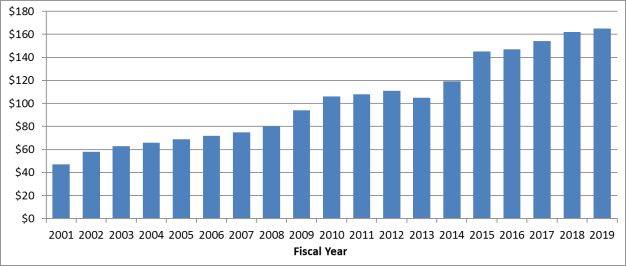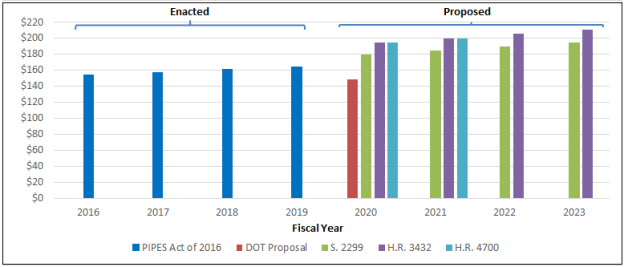Introduction
The federal pipeline safety program is administered by the Department of Transportation's (DOT's) Pipeline and Hazardous Materials Safety Administration (PHMSA), working with state pipeline safety regulators. Together, the federal and state agencies administer comprehensive regulations to ensure the safety of the nation's hazardous liquid (e.g., crude oil) and natural gas pipelines. Under the Protecting Our Infrastructure of Pipelines and Enhancing Safety Act of 2016 (P.L. 114-183), funding authorization for PHMSA's pipeline safety program expired on October 1, 2019. Congress is debating at what levels and for how long the program should next be authorized. The Trump Administration has proposed a reduction in PHMSA pipeline safety funding whereas bills in the House and Senate would increase funding at different levels.
Past Budget Authority
PHMSA's pipeline safety program is funded primarily by user fees assessed on each regulated pipeline operator. PHMSA collects additional fees from underground natural gas storage facility operators to fund storage regulatory activities as part of its pipeline safety program. Much of PHMSA's budget is used to pay safety inspectors, either directly as federal employees or indirectly as state employees through state grants. By statute, PHMSA may pay up to 80% of the cost of personnel, equipment, and activities of a certified state pipeline safety agency. PHMSA's total annual budget authority for pipeline safety has grown somewhat steadily since 2001 (Figure 1). For FY2019, PHMSA's enacted authority is $165 million—more than double the agency's budget authority in FY2008 (not adjusted for inflation).
|
Figure 1. PHMSA Pipeline Safety Total Annual Budget Authority FY2001-FY2019
(Millions of Dollars)
|
 |
|
Sources: U.S. Office of Management and Budget, Department of Transportation.
Notes: Includes funds from the Pipeline Safety Fund, the Oil Spill Liability Trust Fund, and the Underground Natural Gas Storage Facility Safety accounts.
|
Reauthorization Proposals
In a pipeline safety legislative proposal transmitted to Congress on June 3, 2019, Transportation Secretary Elaine Chao proposed budget authority for PHMSA of approximately $149 million for FY2020, with "such sums as may be necessary" for fiscal years 2021 through 2023. This FY2020 budget would be roughly 10% less than the FY2019 budget authority, with proposed reductions primarily in contract programs, research and development, and state grants. On June 26, 2019, the Energy Subcommittee of the House Energy and Commerce Committee advanced the Safer Pipelines Act of 2019 (H.R. 3432) with proposed pipeline safety budget authority of approximately $195 million in FY2020 rising to approximately $211 million in FY2023. On July 31, 2019, the Senate Commerce, Science, and Transportation Committee reported the PIPES Act of 2019 (S. 2299) with proposed budget authority of $180 million in FY2020 rising to $195 million in FY2023. On October 16, 2019, Representative Fred Upton introduced the Pipeline Safety Act of 2019 (H.R. 4700), a two-year authorization which would fund PHMSA at the same levels proposed in H.R. 3432 for FY2020 and FY2021. Figure 2 summarizes the funding proposals. Compared to PHMSA's FY2019 budget authority, the House and Senate bills would increase PHMSA's pipeline safety authorization by roughly 18% and 9%, respectively, for the next fiscal year.
|
Figure 2. PHMSA Pipeline Safety Budget Authority FY2016-FY2023, Enacted and Proposed
(Millions of Dollars)
|
 |
|
Source: U.S. Office of Management and Budget, Department of Transportation, S. 2299 as reported by the Senate Commerce, Science, and Transportation Committee; H.R. 3432 as forwarded by the House Energy and Commerce Subcommittee on Energy to the full committee.
Notes: Includes funds from the Pipeline Safety Fund, the Oil Spill Liability Trust Fund, and the Underground Natural Gas Storage Facility Safety accounts. The DOT proposal contains "such sums as may be necessary" for fiscal years 2021 through 2023, and does not specify an amount for each year.
|
PHMSA Resource Considerations
As Congress has considered funding levels for pipeline safety, the following have been key issues:
- State Grant Levels. Although PHMSA may reimburse states for up to 80% of their pipeline safety expenditures, in 2017 (the latest year for which the data are published) actual grant awards to states covered 68% of state expenditures, on average. Pipeline safety advocates argue that grant levels below 80% hamper the states' ability to maintain the most qualified workforce and perform critical functions. However, DOT and some state officials have countered that states may increase pipeline safety agency funding through state-levied pipeline user fees if they believe they need more resources.
- Inspector Pay. PHMSA has long faced challenges hiring and retaining its own federal inspectors, largely due to industry recruitment of the same candidates PHMSA seeks (engineers). A 2017 DOT Inspector General (IG) report confirmed "a significant gap between private industry and Federal salaries for the types of engineers PHMSA hires." Some in Congress have proposed granting PHMSA special pay authority for engineers to compete with industry. Higher pay for inspectors could require more funding for salaries.
- Rulemaking Resources. Congress has used prior reauthorizations to impose on PHMSA various mandates. Many Members of Congress are concerned that major mandates remain unfulfilled years beyond the deadlines specified in statute. For example, as of July 1, 2019, according to its own assessment PHMSA had not fulfilled six mandates under the Pipeline Safety, Regulatory Certainty, and Job Creation Act of 2011 (P.L. 112-90). According to an IG report, PHMSA's rulemaking processes have contributed to the delays, but some have suggested that staffing limitations may also be a factor. However, the PHMSA administrator testified in 2018 that the agency had adequate staffing and funding for rulemaking.
Authorization Lapse
In situations where PHMSA's authorization expires before reauthorization, PHMSA officials assert that its pipeline safety program can continue to operate and can still be funded based upon its expired authorization, subject to any instructions in an appropriations act. In such cases, PHMSA looks to legislative history to indicate that Congress did not intend for its programs to terminate. Such a circumstance would differ from an appropriations lapse, such as occurred during the 2018-2019 government shutdown. In that specific instance, DOT published a plan for continuing operations which included extensive furloughs of PHMSA's pipeline safety staff, primarily in administrative functions.

